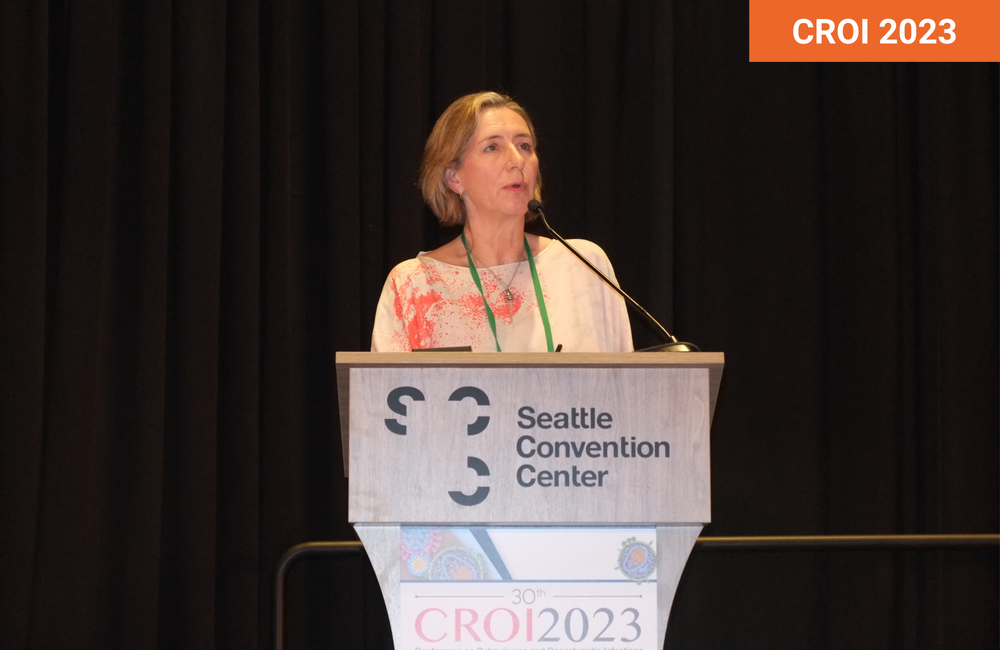
The combination of dolutegravir and darunavir/ritonavir is superior to a boosted protease inhibitor regimen for second-line treatment of people experiencing failure of a first-line regimen containing a non-nucleoside reverse transcriptase inhibitor, Professor Gail Matthews of the University of New South Wales reported on Wednesday at the 30th Conference on Retroviruses and Opportunistic Infections (CROI 2023) in Seattle. The findings come from the D2EFT study, conducted in 14 countries in Africa, Asia and Latin America.
Current World Health Organization (WHO) guidelines issued in 2018 and updated in 2021 recommend that after the failure of a first-line antiretroviral regimen that doesn’t include dolutegravir, people with HIV should receive dolutegravir-based second-line treatment, with a nucleoside (NRTI) backbone chosen by resistance testing or otherwise optimised to avoid cross-resistance with first-line drugs.
Previously, WHO had recommended the use of a boosted protease inhibitor and two NRTIs after the failure of first-line treatment due to absence of evidence about second-line use of dolutegravir. In terms of specific protease inhibitors, darunavir/ritonavir was recommended as an alternative to lopinavir/ritonavir or atazanavir/ritonavir, as a heat-stable formulation was not available at that time.
Darunavir/ritonavir is preferred as a boosted protease inhibitor in European and US treatment guidelines because of its high barrier to resistance but at the time the D2EFT study was planned in 2017, there was little information about its use in low- and middle-income settings.
D2EFT – Dolutegravir and Darunavir Evaluation in adults failing First-line Therapy – was designed to compare the best-in-class boosted protease inhibitor with a new approach: combining darunavir/ritonavir with the integrase inhibitor dolutegravir, each dosed once daily. The potential advantage of this combination is that it would avoid the need for resistance testing or the use of the poorly tolerated NRTI zidovudine, which must be taken twice daily.
A third arm was added to the study in 2018, after recruitment to D2EFT had begun, in which participants were randomised to dolutegravir and recycled tenofovir and lamivudine or emtricitabine (TDF/XTC), following research showing that recycling NRTIs could be effective. For example, the NADIA study showed that dolutegravir or darunavir/ritonavir combined with a recycled nucleoside backbone were equally effective as second-line treatment in people experiencing failure of their first antiretroviral regimen.
The D2EFT study recruited people with HIV who had experienced failure of a first-line regimen consisting of a non-nucleoside reverse transcriptase inhibitor (such as efavirenz) and two NRTIs. They were randomised to one of three arms:
- darunavir/ritonavir + two NRTIs (standard of care)
- darunavir/ritonavir + dolutegravir
- dolutegravir + TDF/XTC
Eligibility criteria included having at least two viral load measurements above 500 more than 24 weeks after starting treatment. The study excluded pregnant women, people with hepatitis B and those with active coinfections such as tuberculosis or other significant co-morbidities.
The study recruited 831 people in 14 low- and middle-income countries in Africa, Asia and Latin America. Most participants (722) joined the study after the third arm was added.
Study participants had a mean age of 39 years, 45% were male, 68% were Black and 25% were Asian. Participants had advanced HIV; the median CD4 count was 206 and the median viral load was approximately 15,000.
Most participants (82%) were taking efavirenz in their first-line regimen.
Participants were randomised to the three study arms in equal proportions. In the darunavir/ritonavir plus two NRTIs study arm, 76% received zidovudine/lamivudine and 19% received tenofovir with lamivudine or emtricitabine.
The primary outcome of the study was the proportion of participants with viral load below 50 at week 48. In those recruited to the original two study arms, 75% in the darunavir/ritonavir + two NRTIs arm had viral load below 50, compared to 84% in the darunavir/ritonavir + dolutegravir arm.
In those recruited after a second dolutegravir-containing arm had been added, 71% in the darunavir/ritonavir arm compared to 84% in the dolutegravir/darunavir arm and 78% in the dolutegravir + TDF/XTC arm had viral load below 50.
In all study participants, darunavir/ritonavir + dolutegravir was superior to the standard of care (difference -8.6%, (95% confidence interval; -15.5, -1.7, p=0.02). Dolutegravir + TDF/XTC was non-inferior to the standard of care (difference -6.7% (-14.4, 1.2, p=0.09).
The average gain in CD4 count at week 48 was superior to the standard of care in both the darunavir/ritonavir + dolutegravir (+56, p<0.001) and the dolutegravir + TDF/XTC arms (+39, p=0.01).
Weight gain was greater in the dolutegravir-containing arms than in the standard of care arm (+2.7kg in the arm with darunavir, p<0.001, and +1.7kg in the arm with TDF/XTC, p=0.006).
Treatment was well tolerated; 14 possibly treatment-related serious adverse events occurred, evenly distributed between the study arms. Twenty-five pregnancies occurred in participants in the dolutegravir study arms with no congenital birth defects.
Although dolutegravir plus darunavir/ritonavir showed superiority over the standard of care in the D2EFT study and has the potential to be made available as a co-formulated tablet, this option will remain more expensive than dolutegravir + TDF/XTC, say the study investigators. As existing supply chain and procurement systems already support widespread availability of dolutegravir + TDF/XTC for first-line treatment in low- and middle-income settings, it’s likely that treatment programmes will prefer to provide it after the failure of first-line NNRTI-based treatment.
Matthews G et al. D2EFT: dolutegravir and darunavir evaluation in adults failing first-line HIV therapy. Conference on Retroviruses and Opportunistic Infections, Seattle, abstract 198, 2023.
